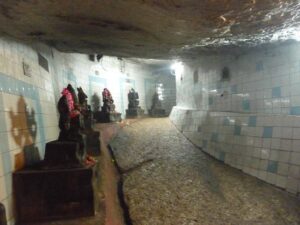
Gavi Gangadhareshwara Temple or Gavipuram Cave Temple, an example of Indian rock-cut architecture, is located in Bengaluru in the state of Karnataka in India.
It is believed that the temple was cut out of a rock in the 9th century. It was used by the great sage Gowthama to perform penance. Later in the 16th century, Kempegowda I, the founder of Bangalore, revamped and extended the temple.
The temple is unique from all other temples of Karnataka due to the presence of two huge discs in the foreground of the shrine.
The Gavipuram Cave Temple is an architectural wonder in itself. The temple was cut out from a natural monolith rock. The inner sanctum of the temple is situated inside a cave carved out in the rock. The main attraction of the temple is the granite pillars situated in the forecourt of the temple. Two of the pillars support huge discs that represent the sun and the moon. The other two pillars have a trident (trishul) and a two-headed drum (damru), representing the two significant possessions of Lord Shiva.
The inner sanctum of the temple has a tall Shivalinga. Another major attraction of the temple is the presence of a rare idol of Agni, the God of fire. The figure has two heads, seven hands and three legs. It is perhaps the only temple in South India that has such an idol. The temple has a wonderful sculpture of Nandi (a bull), Shiva’s mount. A beautiful image of Shakti Ganapathi with 12 hands adorns the left side of the main entrance to the temple.
But the main architectural significance associated with the temple is the creation of the cave temple and the placement of the stone discs in such a manner that they allow the sun to illuminate the Shivalinga for just one hour every year on winter solstice.
Source:
http://www.karnataka.com/bangalore/gavi-gangadhareshwara-temple/


